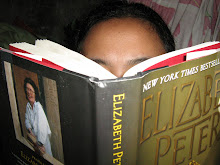(first of four parts)
I am proud to say that I am a product of the Philippine public school system. Since I grew up in a (relatively) remote province in the hinterlands of Mindanao, I was educated in the local public schools from kindergarten to college.
Our elementary school in our barangay had less than ten teachers because each grade had only one section made up of about 45 to 60 pupils. The class adviser for each class, in short, taught all the subjects in her class for the whole day, the periods for each subject marked only by putting away one textbook and opening another. If one had a textbook. We sat two by two on those small benches with a shelf that served as a writing desk for those sitting behind you, and often shared the textbooks, one to each bench. Lucky the child who got a book all to himself! Our teachers often asked us to discuss what we were reading, and to tutor our classmates who had trouble with their lessons. We took as much care as possible of those books-- we were required to have them bound and covered with plastic, and if you lost one, you had to pay for it. Forty pesos per book, in the late '80s and early '90s, was already nearly as much as the miscellaneous fees we paid each year (and some of my classmates were already hard up paying those fees)--- if you lost more than one... horrors! Frequent handling tended to weaken the glue binding and let leaves fall out, so we were required to have the book "bound", which meant boring holes in the spine with an awl then stitching it up with rough twine.
We were supposed to have a school uniform, but it was not strictly implemented. If you had one, you wore it, complete with socks and shoes-- if not, no one would call you on it. Not when some of the other children came to school dirty, ragged and barefoot. If they lived outside the barrio proper, they often walked several kilometers to school. Looking back on it now, I was one of the fortunate ones because my dad and other family members had steady jobs. I went to school in a uniform, including socks and shoes, and I got a new bag, paper, notebooks, pencils, and even crayons each June. I guess I was really a little brat, because my classmates kept stealing my pencils and paper and breaking my crayons-- back then, if you had the 16-color box instead of the 8-color one, and Camel instead of Colora, you were an object of envy, because the Camel colors were really vivid compared to Colora (no offense). Our school uniform was the requisite navy blue jumper (all public elementary school pupils in our place wore navy blue, distinguished only by little details such as the number of straps on the jumper), with wide shoulder straps connected to the waistline and one strap each across the back and front, and a white blouse with a baby collar (rounded instead of pointed ends) and puffed sleeves. We were supposed to wear white socks and black shoes with it, but most of the time, my classmates just wore white t-shirts and chinelas with the jumper. By the time I was in Grade Two, I had also opted to do the same, to my mother's sorrow. I even took off my shoes to participate in games, since my bare feet seemed to offer so much more traction while running than the soles of my leather shoes.
I was fortunate in that I often had new things at each start of the school year. Many of my classmates used the "butas-butas" or net string bags used at the market for school bags, and you could see the contents-- one tattered notebook, one pencil, ten sheets of pad paper. Oh, yes, and the "baon" or packed lunch. Few of them used plastic "tupperware" containers; more often than not, they just wrapped some boiled rice and two pieces of broiled tuyo in a banana leaf. Or sometimes, instead of the tuyo, a steamed eggplant and a dab of guinamos, or a boiled egg, or eggs scrambled with guinamos, or steamed eggplant fried with guinamos. Maybe it was being wrapped in a banana leaf that made it all taste better than baon carried in a plastic container, coz my mom was so mad when I wanted to bring baon to school in a banana leaf even when we lived only a block away from the school and had many tupperware lunchboxes at home. Sometimes, I brought some of my classmates home for lunch so that I could get at their baon because I was trying to figure out why their food seemed to taste so much better than what we had at home!
We didn't have a playground. I only knew what swings and slides looked like from books and magazines. There was a portion of the school grounds that was supposed to be a playground with swings, but all that remained were the upright supports made of metal tubes, which we often climbed on. We didn't miss having a playground, though. For an elementary school with only six classes, we had lots of buildings (most of them boarded up) and very extensive school grounds. We had vast lawns, concrete fences with corner blocks that invited climbing, and lots of plants and trees, including an ipil-ipil mini-forest, a banana plantation, flower and vegetable gardens, and wide cornfields. The fences were low, about four feet in height, except for the parts where the iron gates were attached. These had tall square blocks about seven feet tall on either side of the gate, and these blocks were about four feet square and hollow enough inside, like a miniature porch or crow's nest, to let one crouch down and not be easily found in a game of hide and seek. Other good hiding places were tree branches, the middle of several clumps of ornamental Chinese bamboo, the interior of the culverts in the ditch that surrounded the school, and tall grasses. Aside from hide and seek (panagu-ay), we also played "igo-ay", "chinese garter", "one and one", "langit lupa impiyerno" (heaven, earth, and hell), "bago-bagoong", "lantay-lantay", "shakay", and "pityaw", and had a lot of fun.
Recess time was 9:oo am; there was no recess in the afternoon. My daily allowance used to be one peso, most of my classmates had even less. I often bought a stick of banana-q for 25 centavos and a "cold-mix" or orange juice packed in a plastic bag, for another 25 centavos. Or an ice candy, or two boiled saba bananas, or a turon or maruya, at the same price. No sandwiches, burgers, spaghetti or pancit. At first my mom made me bring a glass of milk and a sandwich to school, but I liked buying food from the vendors, so she stopped giving me baon. The vendors only came to the school gate at around 8:30 and packed up and left at about 10:30, and we didn't have a school canteen!
We had such wide school grounds and no janitors, so we had to do a lot of maintenance work around the school. I think we spent about two hours a day on cleaning, like sweeping floors and weeding gardens and pruning plants-- we called it YCAP and until now I don't really know what that acronym stood for! (Clue: this was around the time of the first EDSA Revolution.) The hard part was harvest time. The school had cornfields, and hired someone to plant the corn, but we weeded and harvested it. It was a less onerous task for most of my farm bred classmates, but my family didn't have a farm, and I didn't have the least idea about farm work. I learned, suffering a lot of allergies, cuts and blisters in the process. After harvest, we husked the corn and dried it, then sold it in town. The fun part was that each class got their part of the proceeds from the sale of the corn, which we then used for activities like the annual Christmas party. The school vegetable garden was another matter; each pupil had his or her own plot in the garden, which he or she planted and took care of. When the vegetables were harvested, we each got our own share of the camote, gabi, talong, ampalaya or calabasa that we planted. Looking back on it now, I guess I took it for granted when I brought home a sack full of vegetables, but perhaps for some of my classmates those vegetables let them and their families eat well even when they didn't have any money.
There were many times when we didn't have school because our teachers were at conferences or were sick, and since there were so few of them, no one could take over someone else's class. We also often didn't have any proper lessons when there were scheduled events or festivities that we had to take part in, because the participants had to practice and the teachers had to take time from their classes to train and supervise them. Even then, our small barrio school bagged several top prizes in municipal, provincial and even regional events like the NAMCYA Choir Competition and the Speechfest competitions.
Now, looking at all those children going to school here in Manila with their yayas and their school services and their security guards and classrooms with electric fans and air conditioners, their elaborate uniforms and trolley bags and expensive school supplies, their big school canteens with a dizzying array of choices, their computers and playgrounds, I still don't know which of us had the more fun. I do know which of us spent less, though. Although many people would look down on public schools, especially a small barrio school like ours, I wouldn't knock the education I got there. I learned to work, to use my imagination, to make do with what was available, and to hone my skills without knowing what the competition was like out there.
(to be continued)
Five Dramas That Are My Equivalent Of Comfort Food, Part 2
-
So, yes, well. I've added to my "comfort dramas" list in the meantime. You
know which ones I'm referring to... the dramas you tend to go back and
rewatch w...
12 years ago











